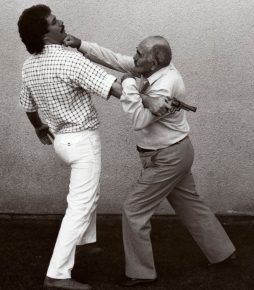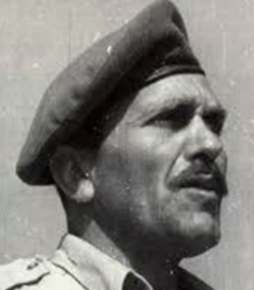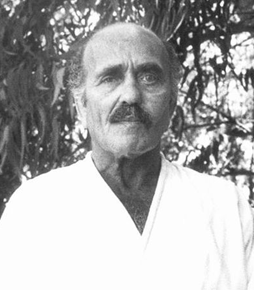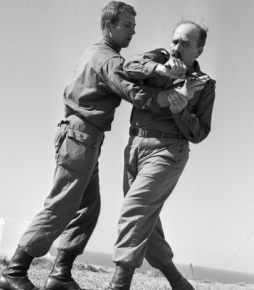history
Over the decades, many legends about Krav Maga have been created and repeated in various sources, nowadays mainly in online publications. Most of them claim that Krav Maga was developed by Imi Sde-Ori (Emrich Lichtenfeld, 1910-1998) and is a self-defence method used by the Israeli army.
Imi’s role is central to the self-defence that is practised today as krav maga around the world. Without denying Imi’s central role in the development and promotion of the sport, however, it should be noted that its roots go back a long way in modern Jewish history, to the need of Jews to protect themselves in the Diaspora and to the long process that preceded the establishment of the State of Israel. Historical research shows that Krav-Maga was formed many years before the State of Israel became independent, the Israel Defense Forces were established or Imi moved to the Land of Israel in 1942. However, Imi is the person who is the reason why we practice the Krav Maga self-defence that is now adapted for civilians.




Emrich Lichtenfeld was born in 1910 in Budapest to a Hungarian-Jewish family and grew up in Bratislava, Slovakia, where his father, Samuel Lichtenfeld, a former circus officer and boxer, was a senior police detective and also owned a gym and coached wrestling, boxing and weightlifting. Imi practised gymnastics, wrestling and boxing, and won several wrestling and boxing competitions in various sporting events at European level. Attacks against the Jewish population in Eastern Europe worsened considerably from the mid-1930s onwards and Imi, along with other young Jewish men, often took part in conflicts in an effort to protect the Jewish population and prevent pogroms. In 1940 Imi left Bratislava and travelled in a circuitous route to Palestine-Eretz Israel, where he arrived in 1942. Imi was recruited as a KAPAP combat instructor in Palmach, where he served until the establishment of the State of Israel. From the above organisations, fighters and fighting methods, the Young State Defence Forces were formed in 1948, and Imi, among other instructors and fighters, also joined the Israel State Defence Forces.
After the transition to the armed forces, the KAPAP types also remained the same and the former instructors continued to teach combat fitness and close combat skills to the soldiers. Although sticks remained a part of KAPAP until the 1960s, their use was gradually phased out.
KAPAP was called Krav-Maga as early as late 1948 and both names were used interchangeably to refer to hand-to-hand combat. Noah Gross mentions that the name Krav-Maga may have a connection with armed hand-to-hand combat. Despite the varying ‘terminology, there was no major change in the KAPAP disciplines, their content or instruction. Each sport, ‘jiu-jitsu’, boxing, stick and knife, and occasionally bayonet, was taught separately. It is clear that until the mid-1950s, Palmach’s instructional material was used.”
In the new army, new forces and units emerged, and new combat doctrines developed, which meant that guided sports and instruction/training hours were adapted to the needs of the units, exercises were removed and others were added or adapted to the new situation. In the late 1950s and early 1960s, the focus of KAPAP/Krav-Maga training shifted from stick to military ‘jiu-jitsu’. Imi Lichtenfeld was behind this change. In the 1960s new weapons were introduced, instructors changed and the stick was completely dropped from KAPAP.
After moving from Palmach to the Israel Defense Forces, Imi was one of the leading instructors of the Combat Fitness/KAPAP. The first unit leader at the time was Moshe Finkl-Zohar, head of the Palmach Combat Training Unit. In 1953, the Krav Maga Professional Committee, under Imi’s leadership, reviewed the KAPAP styles in accordance with its terms of reference and reduced the scope of the material taught to soldiers from the various units. Under the heading of martial arts, three disciplines were introduced: KAPAP, boxing and knife fighting. “Throughout the first decade of the armed forces (1948-1958), the synonyms ‘practical judo’, KAPAP (hand-to-hand combat) and Krav-Maga were used for martial arts.” In the late 1950s, close combat became the core of empty-handed fighting against an enemy armed with various weapons, and the first manual was published, entitled ‘Krav-Maga’.

Imi was practically the main director since 1953. As part of the restructuring of the armed forces, Imi’s Gufani (physical fitness) department and its Krav Maga subdivision were established in 1960, and Imi Lichtenfeld was appointed chief Krav Maga instructor. During his service, Imi instructed and commanded many instructor courses and through his development work brought the Krav-Maga system into full form.
Imi retired from military service in 1962, 20 years after moving to Eretz-Israel in 1942. In 1964, Imi Sde-Or (Lichtenfeld) introduced Krav-Maga to the civilian world in the ‘Machon Imi’ gym he founded in Netanya and later in Tel Aviv, thus extending the method to the civilian world, where it has slowly developed in Israel. Imi then went on to work as a consultant and instructor for various security and defence forces. Imi believed that the more martial arts you master, the better your Krav-Maga skills will become.
In Imi’s training hall grew several followers of his path, such as Eli Avikzar, who was the first to receive a black belt in Krav-Maga from Imi (1971). Following him were Dan 1 black belts Rafi Elgrissy (1973), Haim Zut, Shmuel Kurtzveil, Hakani Haim, Shlomo Avisra and Victor Bracha (1975), Yaron Lichtenstein, Avner Hazan (1978), Avi Abeceedon (1979) and Miki Asulin (1980).
Krav Maga Self-Defence Analysis
For more information, see the krav self-defence analysis, which will be sent to your inbox when you subscribe to the newsletter


